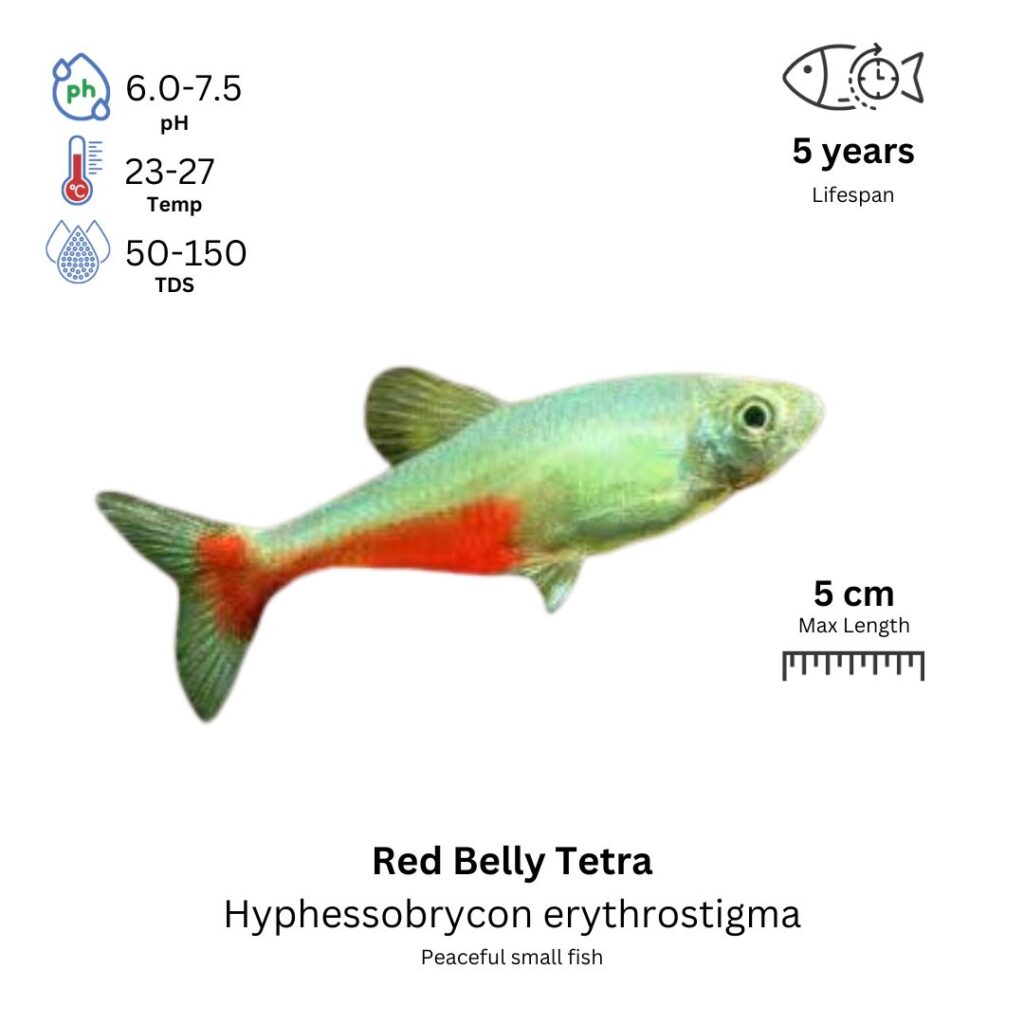Red Belly Tetra
Hemigrammus rhodostomus

Description
The Red Belly Tetra is a small, vibrant species of tetra known for its striking coloration. As the name suggests, these fish have a distinctive bright red or orange belly that contrasts beautifully with their silvery, translucent body. The red coloration is more intense on the lower part of the body, especially near the belly and ventral area. Males tend to be more brightly colored than females, with a vivid red belly and a slightly slimmer, more streamlined body. They have a slender, elongated body and small fins that give them a graceful, fast-swimming appearance. Red Belly Tetras are peaceful and social fish, often seen swimming in schools, making them ideal for community tanks.
Habitat Origin
Native to the rivers and streams of South America, particularly in Brazil and Guyana. They are commonly found in slow-moving, clear waters with plenty of submerged vegetation, where they swim in groups and feed on small invertebrates, plant matter, and organic detritus.
Aquarium
Ideal Number in Aquarium: At least 6 individuals, as they are schooling fish and feel more secure in groups.
Favorite Food

Red Belly Tetras are omnivores and will accept a variety of foods, including high-quality flake food, micro pellets, and live or frozen foods such as brine shrimp, daphnia, and bloodworms. They will also consume algae, biofilm, and detritus, making them a great addition to planted tanks. A varied diet ensures they maintain vibrant colors and overall health.
Behavior:
The Red Belly Tetra is peaceful, social, and active. They are schooling fish and thrive in groups of at least 6, where they feel more secure and exhibit their natural behavior. These tetras are usually seen darting through the middle and upper regions of the tank, where they swim gracefully in a coordinated fashion. They are non-aggressive and typically coexist well with other small, peaceful fish. However, they may become shy or stressed if kept alone or in small numbers, so it’s essential to keep them in a group. They are not known for fin-nipping or territorial behavior, making them suitable for community aquariums.
Special Care:
Red Belly Tetras thrive in a well-planted tank with plenty of hiding spots, such as plants, driftwood, and rocks. They prefer slightly acidic to neutral water conditions and benefit from stable water parameters. Regular water changes and good filtration are essential to maintain water quality, as these fish are sensitive to poor conditions. A moderate water flow is ideal, as they are accustomed to slower-moving waters in their natural environment.
Compatibility with Other Fish:
Yes, Red Belly Tetras are ideal for peaceful community tanks. They can be kept with other small, non-aggressive fish such as other tetras, rasboras, small catfish, and shrimp. Their peaceful nature and schooling behavior make them a great addition to mixed-species tanks. Avoid keeping them with large or aggressive fish, as these species may intimidate or prey on them. They do best with other species that occupy different areas of the tank (such as bottom dwellers or surface dwellers).
Breeding Setup
A separate breeding tank is highly recommended for Red Belly Tetras to prevent egg predation and maintain optimal conditions. A 10-gallon tank (38 liters) is suitable for a breeding group, while a 20-gallon tank (75 liters) is better for multiple pairs. Maintain pH 6.0–7.5, temperature 24–28°C (75–82°F), and hardness 2–10 dGH. Use a gentle sponge filter to avoid strong currents. Add fine sand or gravel, Java moss, Hornwort, or floating plants to offer egg-laying surfaces and hiding places for the fry. Keep lighting moderate, with a 12-hour day/night cycle.
Conditioning for Breeding
Feed Red Belly Tetras a nutrient-rich, varied diet to prepare them for breeding. This includes high-quality flakes or pellets, live or frozen foods like brine shrimp and daphnia, and vegetable matter such as spinach or peas. Weekly 20–30% water changes are essential. To stimulate spawning, perform a larger 50% water change and increase the temperature slightly to 28°C (82°F) to mimic seasonal rainfall that triggers natural breeding.
Spawning Behavior
Spawning usually occurs in the early morning or shortly after water changes. Males will display their vivid red coloration to attract females. Eggs are scattered across the tank, especially on plants or other surfaces. A female may produce 30–50 sticky eggs per spawning session. To protect the eggs, remove the adults immediately after spawning, as they may consume their own eggs or newly hatched fry.
Fry Care
Red Belly Tetra eggs hatch within 24–36 hours, depending on temperature. Newly hatched fry will feed on their yolk sacs for a few days before requiring food. Begin feeding with infusoria or liquid fry food, then move on to baby brine shrimp, microworms, or crushed flakes. To maintain water quality, perform small daily or alternate-day water changes (10–20%). Keep the temperature stable at 24–28°C, and avoid overfeeding to prevent ammonia spikes.
Key Considerations
Red Belly Tetras reach breeding maturity at 6–12 months of age. Males are typically smaller and more colorful, with intense red hues, while females appear larger and rounder, especially when gravid. To support breeding success, avoid sudden changes in water conditions and eliminate stressors such as aggressive tank mates. Consistent maintenance and a calm environment will greatly improve breeding outcomes.
